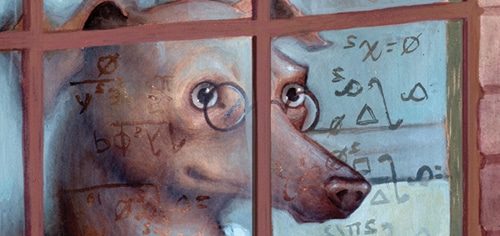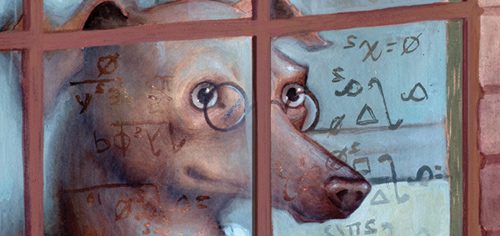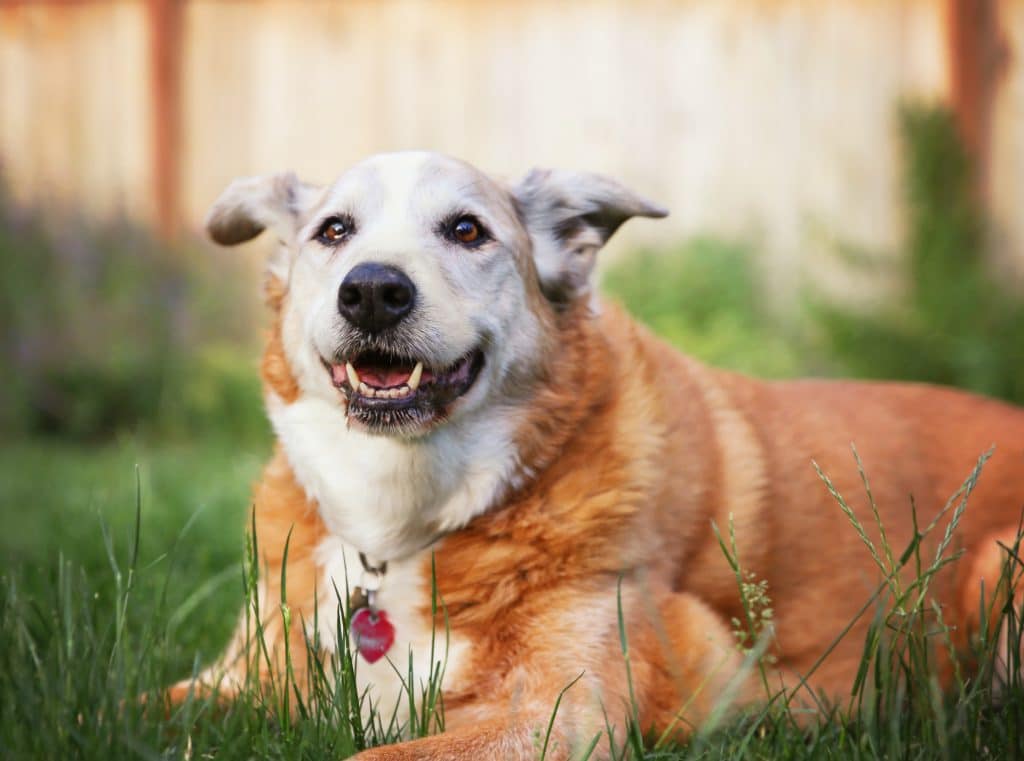

Protect Your Dog’s Mind From the Effects of Aging
Keeping your dog mentally sharp
Wizard, my 12-year-old Cavalier King Charles Spaniel, was showing behaviour changes. Sometimes he seemed to forget what he was supposed to do when given familiar commands. There was an occasional “accident” in the house and, other times, when let out into the yard to relieve himself, he seemed to forget what he was there for and he would stand at the top of the stairs looking puzzled. Once he found himself in a corner between two pieces of furniture and seemed unable to figure out how to back himself out. In general, he seemed to respond more slowly and hesitantly to everything. Like many older dogs, Wizard’s problem was that he was showing the effects of an aging brain.
No one knows exactly why dogs or humans decline in their mental abilities when they age. One theory suggests that as the genetic material (DNA) reproduces itself in each new cell, the successive transcriptions become less accurate, sort of like making copies of copies of copies on a photocopier, where each one gets progressively grainier and harder to read. Damage to the DNA can also come about due to natural radiation from cosmic rays and from more terrestrial sources, such as breathing in air pollutants or fumes from certain solvents. Other theories of aging blame simple wear and tear, suggesting that various physical and neural systems break down from frequent use and may break down even faster if they are put under stress.
Regardless of the source of aging effects, the brain and nervous system of dogs (and people) change markedly as they age. Old dogs have smaller, lighter brains than young dogs. The change is quite significant and the older brain might be up to 25 percent lighter. It is important to note that this change is not necessarily due to brain cells dying off. Actually, we mostly lose parts of the nerve cells, the branches (dendrites and axon filaments) that connect with other nerve cells. These connections to other cells start to break down with age. If we think of the brain as a complexly wired computer, it would be as if various circuits in the central processor simply stopped functioning because connections were broken. For the most part, it is the loss of these connections that reduces the size and the weight of the brain.
With age, there are also chemical changes occurring in the brain that affect behaviour, memory, and learning. In dogs and humans, the mitochondria, little strand-like structures in the nucleus of cells that are responsible for converting nutrients into energy, begin to release “free radicals,” chemicals that oxidize compounds essential for normal cell function. The loss of these compounds places the cell at risk. As the tissues degenerate, protein deposits called amyloids accumulate in the brain. High levels of amyloids, especially when associated with clusters of dead and dying nerve cells, are taken as part of the evidence that an individual is suffering from Alzheimer’s disease. Physical evidence, found only in autopsies, reveals similar degenerative brain lesions in aging dogs and aging humans. Studies conducted at the University of Toronto by a team of researchers including psychologist, Norton Milgram, have shown that dogs with high levels of amyloids in their brains have poorer memories and difficulty learning new material, especially if it involves more complex thinking and problem solving. This equivalent to Alzheimer’s disease in dogs is called Canine Cognitive Dysfunction Syndrome.
If your dog has this problem, you might notice that he is showing behavioural changes much like those I saw in Wizard. These typically include forgetfulness, disorientation, not recognizing family members, sleep disruption, and other lapses in normal mental behaviour.
Canine Cognitive Dysfunction is remarkably common and based upon the available data, it appears that 25 percent of dogs older than 10 years of age show at least one of the major symptoms associated with brain aging. In dogs 15 years of age, more than 60 percent are affected to some extent.
Recent research has shown that one of the most significant factors in avoiding a decline in thinking ability involves keeping mentally active. People who engage in challenging mental activities, such as solving crossword puzzles, playing games, engaging in new activities, taking courses, traveling, reading, or engaging in social activities with many different people, are more likely to avoid an age-related decline in mental ability. Milgram’s University of Toronto research group has demonstrated that by keeping aging dogs mentally active, the mental deterioration observed in learning and problem-solving can be greatly slowed or even reversed.
For someone living with a pet dog, setting up new problems and experiences to keep your dog’s aging brain from deteriorating can be a bit challenging, although it can be done. However, if we consider how and why evolution developed brains in the first place, a simpler alternative solution suggests itself.
If we could jump back into the dim past, say half a billion years ago, we would see the first nervous systems starting to appear. The original purpose for a nervous system was to coordinate movement, so an animal could go find food instead of waiting for the food to come to it. Jellyfish and sea anemones are similar to the first animals that created connected patterns of nerve cells to communicate to their musculature. This gave them a tremendous advantage over animals like sponges that waited brainlessly for dinner to arrive. It can be shown that animals that move quickly and frequently tend to have larger and more complex brains than similar classes of animals that are not as active.
After millions of years of evolutionary experiment, nervous systems evolved some complex ways of going out to eat. However, the goal of the brain remains the same: to coordinate movements. It is interesting to note that a diminished ability to move is a good indication of the effects of aging. You might say that inflexibility heralds the approach of death, while a flexible body which is capable of making fluid movements that must be synchronized by an agile active brain, is a hallmark of youth.
If this line of reasoning is correct, then perhaps increasing physical activity may help to strengthen the brain and offset the effects of aging in the same way that increasing mental activity does. Scientists already know from laboratory experiments that rats that spend a lot of time running in exercise wheels have better brains than their layabout lab mates. Their brains do not show as much shrinkage with age as their inactive comrades, and the effects are most marked on those areas of the brain that are often associated with memory functions and reasoning, such as the hippocampus and areas of the frontal and parietal lobes.
Exercise has been shown to affect human brains in the same way. Studies of senior citizens who walk regularly showed significant improvement in memory skills compared to sedentary elderly people. Walking also improved the learning ability, concentration, and abstract reasoning in people who walked as little as 20 minutes a day. Furthermore, research from the Salk Institute demonstrates that physical exercise has a protective effect on the brain and its mental processes, and may even help prevent Alzheimer’s disease. Their data was based on exercise and health data from nearly 5,000 men and women over 65 years of age which showed that those who exercised were less likely to lose their mental abilities or develop dementia, including Alzheimer’s.
Walking seems to be especially good for your brain because it increases blood circulation and the oxygen and glucose that reach your brain. Walking is not strenuous, so your leg muscles don’t take up extra oxygen and glucose like they do during other forms of exercise. As you walk, you effectively oxygenate your brain. (Maybe this is why walking can “clear your head” and helps you to think better.) As in all kinds of movement and exercise, walking increases breathing and heart rate so that more blood flows to the brain, enhancing energy production and waste removal. Studies show that in response to exercise, cerebral blood vessels can grow, even in middle-aged sedentary animals.
A five-year study at the Laval University in Sainte-Foy, Quebec, suggests that the more a person exercises, the greater the protective benefits for the brain. Inactive individuals were twice as likely to develop Alzheimer’s, compared to those with the highest levels of activity (exercised vigorously at least three times a week). But even light or moderate exercisers (a minimum of a 30-minute walk at least three times a week) reduced their risk significantly for Alzheimer’s and mental decline. It is almost as if the brain has a built-in pedometer and a mechanism where the more steps that you take, the higher the protective benefits to your brain, and the lower your risk is for mental decline with age.
While the vast majority of the research has been done on rats and, more recently, on humans, the University of Toronto’s research team has replicated many of these findings with dogs. There is certainly no reason to expect that the nervous system of dogs would respond differently than those of the other mammals that have been tested so far.
So the implications appear to be quite clear. If you have an aging dog and you want to offset the kind of mental declines that we normally expect in older canines, or even if you have a senior dog who was beginning to show signs of memory loss or other symptoms of canine cognitive dysfunction, a simple way to slow the deterioration of his mind, and perhaps offset the effects of aging, involves simply clipping a leash onto your dog’s collar and taking a walk. The more frequently you walk and the longer the walks, the slower the mental decline with age. Of course, the research suggests that your brain will reap the same benefits and the same protection from aging that your pet dog gets while you are walking him.
Join the newsletter and never miss out on dog content again!
"*" indicates required fields
By clicking the arrow, you agree to our web Terms of Use and Privacy & Cookie Policy. Easy unsubscribe links are provided in every email.









